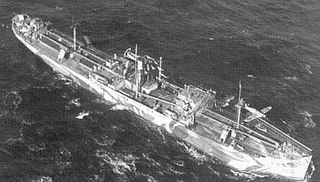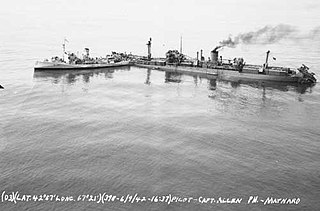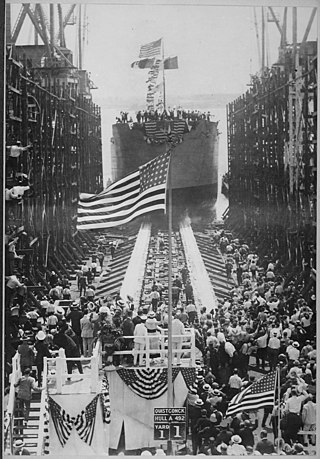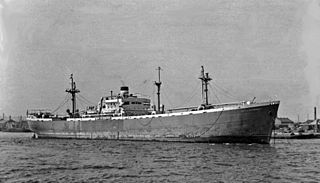Empire Copperfield was a 6,013 GRT cargo ship that was built in 1943 by William Pickersgill & Sons Ltd, Sunderland, United Kingdom. She was built for the Ministry of War Transport (MoWT), spending much of her war service in the Mediterranean. Towards the end of the war she was serving in the Indian Ocean. In 1946 she was sold into merchant service and renamed Graigwen. A sale to India in 1958 saw her renamed Jag Devi. She served until 1963, when she was scrapped.
Empire Cromwell was a 5,970 GRT cargo ship that was built in 1941 by William Pickersgill & Sons Ltd, Sunderland, Co Durham, United Kingdom for the Ministry of War Transport (MoWT). She was torpedoed and sunk off Trinidad on 28 November 1942 by U-508.

Empire Darwin was a British 6,765 GRT CAM ship built in 1941 by William Gray & Co. Ltd., West Hartlepool, United Kingdom for the Ministry of War Transport (MoWT). Her Hawker Sea Hurricane was involved in the last action by an aircraft flown off a CAM ship, shooting down a Focke-Wulf Fw 200 Condor on 28 July 1943.
MV Empire Day was a 7,241 GRT cargo ship that was built in 1941 as a CAM ship by William Doxford & Sons Ltd, Sunderland, Co Durham, United Kingdom for the Ministry of War Transport (MoWT). In 1943, she was converted to a standard cargo ship. She served until August 1944 when she was torpedoed and sunk by U-198.
Empire Deed was a 6,766 GRT cargo ship that was built in 1943 by Bartram & Sons Ltd, Sunderland, Co Durham, United Kingdom the Ministry of War Transport (MoWT). In 1946, she was sold into merchant service and renamed Deed. In 1951, she was sold to Panama and renamed Doro. A sale to Greece in 1956 saw her renamed Leonidas Cambanis. In 1964, she was sold to Liberia and renamed Ever Fortune followed by a sale to Taiwan later that year and renaming to Ever Happiness. She served until 1967, when she was scrapped at Kaohsiung, Taiwan.
Kollbjørg was a 8,236 GRT tanker that was built in 1941 as Empire Diamond by Harland & Wolff, Belfast, United Kingdom for the Ministry of War Transport (MoWT). She was transferred to the Norwegian Government in 1942 and renamed Norsol. In 1946 she was sold into merchant service and renamed Kollbjørg. A sale to Sweden in 1956 saw her renamed Storo, she served until 1959 when she was scrapped.
Esso Appalachee was a 9,819 GRT tanker that was built in 1942 as Empire Dickens by Furness Shipbuilding Co Ltd, Haverton Hill-on-Tees, County Durham, United Kingdom for the Ministry of War Transport (MoWT). In 1946, she was sold into merchant service and renamed Esso Appalachee, serving until 1960, when she was scrapped.
Empire Driver was a 7,042 GRT cargo ship that was built in 1942 by William Gray & Co Ltd, West Hartlepool, Co Durham, United Kingdom for the Ministry of War Transport (MoWT). In 1945, she was transferred to the French Government and renamed Radiotélégraphiste Biard. She was sold to an Italian company in 1950 and renamed Dea Mazzella. In 1956, she was renamed Maria Mazzella. Further sales in 1960 and 1964 saw her renamed Falzarego and Grazia Prima respectively. In 1965, she was sold to Liberia and renamed Missouri. She served until 1969 when she was scrapped.
Norholm was a 9,813 GRT tanker that was built in 1942 as Empire Druid by Sir J Laing & Sons Ltd, Sunderland, Co Durham, United Kingdom for the Ministry of War Transport (MoWT). In 1942, she was transferred to the Norwegian Government and renamed Norholm. She was sold into merchant service in 1946, and renamed Haukefjell. Fitted with a new engine in 1949, she was sold to Panama in 1952 and renamed Bluewater. She served until 1959, when she was scrapped in Japan.
Habib Marikar was a 7,067 GRT cargo ship that was built in 1943 by Short Brothers Ltd, Sunderland, Co Durham as Empire Duchess for the Ministry of War Transport (MoWT). She was sold into merchant service in 1949 and renamed Braemar Castle. A further sale in 1950 saw her renamed King James.
Empire Emerald was a 8,032 GRT tanker that was built in 1941 by Furness Shipbuilding Co Ltd, Haverton Hill-on-Tees, Co Durham, United Kingdom for the Ministry of War Transport (MoWT). She was sold into merchant service in 1946 and renamed El Gallo, serving until 1959 when she was scrapped.

Kronprinsen was a 7,078 GRT cargo ship that was built as Empire Fairbairn in 1942 by Barclay Curle & Co, Glasgow, Renfrewshire, United Kingdom for the Ministry of War Transport (MoWT). She was transferred to the Norwegian Government before completion and renamed Kronprinsen. She served until 9 June 1942, when she was torpedoed and damaged by U-432 off Cape Sable Island, Nova Scotia, Canada. She was under repair until October 1943.

Quistconck was a 5,144 GRT Design 1022 Hog Islander that was laid down as Red Jacket in 1918 by the Stone & Webster subsidiary American International Shipbuilding Corp., Hog Island, Philadelphia, Pennsylvania, United States for the United States Shipping Board (USSB). Launched as Quistconck, she was sold to Lykes Brothers - Ripley Steamship Co Inc in 1933. In 1941, she was passed to the Ministry of War Transport (MoWT) and renamed Empire Falcon. She was sold into merchant service in 1946 and renamed Barnby. A sale to a Panamanian company saw her renamed Mariandrea. She served until 1953, when she was scrapped.

Monrovia was a 7,067 GRT cargo ship that was built in 1943 by Lithgows Ltd, Glasgow, United Kingdom as Empire Falstaff for the Ministry of War Transport (MoWT). In 1945, she was transferred to the French Government and renamed Commandant Mantelet. She was sold into merchant service in 1950 and renamed Commandant le Bilboul. In 1954, she was sold to a Liberian company and renamed Monrovia, serving until 1959 when she was in collision with another ship in Lake Huron, United States and sank.
Santagata was a 7,049 GRT cargo ship that was built in 1943 by Sir W G Armstrong, Whitworth & Co (Shipbuilders) Ltd, Newcastle upon Tyne, United Kingdom as Empire Farmer for the Ministry of War Transport (MoWT). In 1945, she was sold to the French Government and renamed Administrateur en Chef Thomas. A further sale to Italy in 1950 saw her renamed Santagata. She was wrecked on the Goodwin Sands later that year.

Fort Stikine was a British Fort ship which was built in Canada in 1942. Owned by the American War Shipping Administration, she was leased under charter to the Ministry of War Transport under the Lend-Lease scheme and operated under the management of the Port Line. Fort Stikine only had a short career, and was destroyed in an explosion at Bombay, India, in April 1944 that caused the loss of a further thirteen ships.
Clan Allan was a 7,043 GRT cargo ship that was built in 1942 as Empire Forest by John Readhead & Sons Ltd, South Shields, County Durham, United Kingdom for the Ministry of War Transport (MoWT). She was sold to Clan Line in 1946 and renamed Clan Allan. Sold in 1958 to Bullard, King & Co Ltd and renamed Umtali, she was sold back to Clan Line the following year and renamed Clan Allan. She was sold to Mullion & Co Ltd, Hong Kong in 1961 and renamed Ardsirod, serving until 1966 when she was scrapped.
Redgate was a 7,131 GRT cargo ship which was built in 1945 as Empire Freetown by Burntisland Shipbuilding Co. Ltd., Burntisland, Fife, United Kingdom for the Ministry of War Transport (MoWT). She was sold to B J Sutherland & Co. Ltd. in 1946 and was renamed Inverness. She was sold to Turbull, Scott & Co. Ltd. in 1957 and renamed Redgate. She was sold to Compagnia Marvalia Navigazione SA, Monrovia, Liberia in 1963 and was renamed Agia Elpis. She was sold to Southern Cross Shipping Co. Ltd., Cyprus in 1967 and was scrapped in Shanghai, China in 1968.
Matelots Pillien et Peyrat was a 7,058 GRT cargo ship which was built in 1943 as Empire Friendship by Short Brothers Ltd, Sunderland, County Durham, United Kingdom for the Ministry of War Transport (MoWT). Ownership was transferred to the French Government in 1945, when she was renamed Matelots Pillien et Peyrat She was sold to Compagnie Havraise de Navigation à Vapeur, Paris in 1948. She was driven ashore at Port-de-Bouc, Bouches-du-Rhône in October 1962. Declared a constructive total loss, she was scrapped.

SS Ben H. Miller was a British merchant ship of World War II. A Liberty ship built in the United States in 1943, she was bareboat chartered to the British Ministry of War Transport, with Ellerman and Papayanni as managers. Sold to her managers after the war, she was renamed SS City of Shrewsbury in 1947. Resold in 1959, she became the Compagnia de Navigazione Arcoul's SS Marucla, and was scrapped in 1969. Her original namesake was Ben H. Miller.





